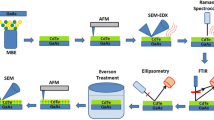Abstract
We present results on the surface morphology and recombination lifetimes of molecular-beam epitaxy (MBE)-grown HgCdTe (211)B epilayers and correlate them with the roughness of the CdZnTe substrate surfaces. The substrate surface quality was monitored by in-situ spectroscopic ellipsometry (SE) and reflection high-energy electron diffraction (RHEED). The SE roughness of the substrate was measured after oxide desorption in the growth chamber. The RHEED patterns collected show a strong correlation with the SE roughness. This proves that SE is a valuable CdZnTe prescreening tool. We also found a correlation between the substrate roughness and the epilayer morphologies. They are characterized by a high density of thin elongated defects, “needle defects,” which appear on most samples regardless of growth conditions. The HgCdTe epilayers grown on these substrates were characterized by temperature-dependent, photoconductive decay-lifetime data. Fits to the data indicate the presence of mid-gap recombination centers, which were not removed by 250°C/24-h annealing under a Hg-rich atmosphere. These centers are believed to originate from bulk defects rather than Hg vacancies. We show that Te annealing and CdTe growth on the CdZnTe substrates smooth the surface and lower substantially the density of needle defects. Additionally, a variety of interfacial layers were also introduced to reduce the defect density and improve the overall quality of the epilayer, even in the presence of less than perfect substrates. Both the perfection of the substrate surface and that of its crystalline structure are essential for the growth of high-quality material. Thus, CdZnTe surface polishing procedures and growth techniques are crucial issues.
Similar content being viewed by others
References
L. He, Y. Wu, L. Chen, S.L. Wang, M.F. Yu, Y.M. Qiao, J.R. Yang, Y.J. Li, R.J. Ding, and Q.Y. Zhang, J. Cryst. Growth 227, 677 (2001).
M. Zandian and E. Goo, J. Electron. Mater. 30, 623 (2001).
R. Triboulet, A. Tromson-Carli, D. Lorans, and T. Nguyen Duy, J. Electron. Mater. 22, 827 (1993).
J.P. Tower, S.P. Tobin, M. Kestigian, P.W. Norton, A.B. Bollong, H.F. Schaake, and C.K. Ard, J. Electron. Mater. 24, 497 (1995).
Nikko Materials USA, Inc., 125 North Price Road, Chandler, AZ 85224.
J.D. Benson, A.B. Cornfeld, M. Martinka, J.H. Dinan, B. Johs, P. He, and J.A. Woollam, J. Cryst. Growth 175, 659 (1997).
G. Badano, J. Garland, and S. Sivananthan, J. Cryst. Growth 251, 571 (2003).
M.C. Chen and R.A. Schiebel, J. Appl. Phys. 71, 5269 (1992).
Author information
Authors and Affiliations
Rights and permissions
About this article
Cite this article
Zhao, J., Chang, Y., Badano, G. et al. Correlation of CdZnTe(211)B substrate surface morphology and HgCdTe(211)B epilayer defects. J. Electron. Mater. 33, 881–885 (2004). https://doi.org/10.1007/s11664-004-0215-6
Received:
Accepted:
Issue Date:
DOI: https://doi.org/10.1007/s11664-004-0215-6



